
Coris is a genus of wrasses, collectively known as the rainbow wrasses, found in the Atlantic, Indian, and Pacific Oceans.

Scorpaenopsis is a genus of marine ray-finned fish belonging to the family Scorpaenidae, the scorpionfishes. The fishes in this genus are found in the Indian and Pacific Ocean.
Pascua is a genus of gobies native to the Pacific Ocean. The origin of the name "Pascua" is from the Spanish for "Easter" in recognition of the Easter Island range of the type specimen.

Ctenogobiops is a genus of marine gobies native to the Indian and Pacific oceans.

Ctenochaetus, or bristletooth tangs, is a genus of marine ray-finned fish belonging to the family Acanthuridae, which includes the surgeonfishes, unicornfishes and tangs. These fishes are found in the Indo-Pacific region. They have many, small flexible teeth and some species have the common name bristletooth.

Pseudocheilinus is a genus of wrasses native to the Indian and Pacific Oceans.
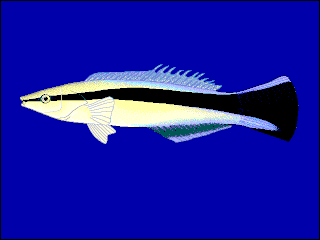
Labroides is a genus of wrasses native to the Indian and Pacific Oceans. This genus is collectively known as cleaner wrasses, and its species are cleaner fish.
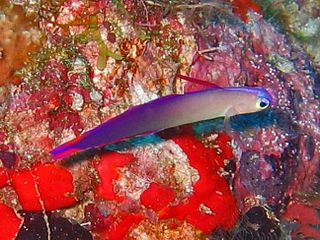
Nemateleotris is a genus of dartfishes native to the Indian and Pacific oceans.
Gnatholepis is a genus of fish in the family Gobiidae, the gobies. It is the only marine genus in the subfamily Gobionellinae, which otherwise includes mostly estuary-dwelling and freshwater fish. Gnatholepis are tropical fish associated with sandy habitat around corals.

The largetooth goby, also known as Wilbur's goby, is a species of ray-finned fish from the family Gobiidae which is native to the Indo-Pacific from the Seychelles to Micronesia. Its known range has been extended to the Red Sea as specimens were photographed at one site and collected at another site off Egypt. This species lives in sheltered marine waters at depths of from 0 to 20 metres preferring areas with sandy substrates. This species grows to a length of 6.5 centimetres (2.6 in) SL. This species is the only known member of its genus. This species is not obviously sexually dimorphic and it has a background colour of pale brown to greenish-brown and a pale ventral side. The body is marked with brown and white spots, pairs of larger brown spots create a mid-lateral row along its flanks and there is a dark spot on the caudal fin peduncle. It has a brown blotch on the cheek and a series of short brown bars along its back. The largetooth goby is a solitary fish which is found in coastal bays, lagoons and estuaries over fine sandy substrates close to the margins of reefs or silt beds in the vicinity of sheltered and often turbid coastal reefs. It is most frequently collected from shallow waters to 7 metres (23 ft), around coral reefs but off southern Japan, the largetooth goby occurs at the bottom of sandy bays. The specific name honours the American physician, Ray Lyman Wilbur (1875–1949) who was president of Stanford University from 1916–1943, as well as being the United States Secretary of the Interior from 1929–1933. Wilbur helped the author, Herre, get to Palau, the type locality of this species.
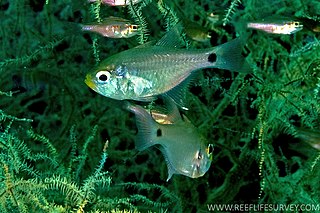
Archamia bleekeri, also known as Gon's cardinalfish, is a species of fish in the family Apogonidae, the cardinalfishes. It is native to the coastal waters of the Indian Ocean and the western Pacific Ocean from Africa to Indonesia and from Taiwan to Queensland, Australia. This species occurs in mangrove forests and reefs, and is an inhabitant of shipwrecks, preferring silty areas with muddy or sandy substrates. This species grows to a total length of 10 cm (3.9 in). This species is the only member of the genus Archamia. The other species were moved to the new genus Taeniamia in 2013.
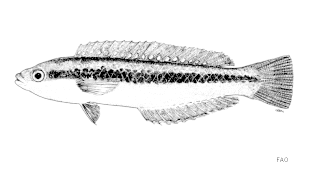
Leptojulis is a genus of wrasses native to the Indian Ocean and the western Pacific Ocean.

Polylepion is a genus of wrasses native to the Pacific Ocean. It is also known as a bleeding wrasse. They are mostly found over sandy waters from Mexico to Nicaragua, including Cocos Island.
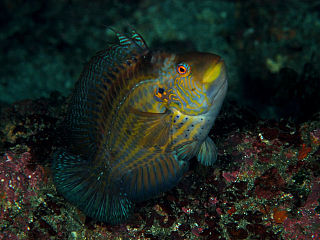
Pteragogus is a genus of wrasses native to the Indian Ocean and the western Pacific Ocean.
John Ernest "Jack" Randall was an American ichthyologist and a leading authority on coral reef fishes. Randall described over 800 species and authored 11 books and over 900 scientific papers and popular articles. He spent most of his career working in Hawaii. He died in April 2020 at the age of 95.

Pempheris is a genus of sweepers native to the Atlantic, Indian and Pacific Ocean.

Novaculops woodi, the Hawaiian sandy or Wood's wrasse, is a species of marine ray-finned fish from the family Labridae, the wrasses. This wrasse is endemic to the Hawaiian Islands in the Pacific Ocean where it is found in areas of sandy rubble as depths of less than 48 metres (157 ft). Novaculops woodi was originally described as Xyrichtys woodi in 1901 by the American physiologist and histologist Oliver Peebles Jenkins (1850-1935) with the type locality given as Honolulu. peebles gave this species the specific name woodi in honour of the Stanford University professor of hygiene Thomas Denison Wood.

Novaculops pastellus, the Lord Howe sandy, is a fish of the family Labridae, subfamily Xyrichtyinae, commonly known as razorfishes. It's a rare fish known only from the Lord Howe Island region in the Tasman Sea, and inhabits open sandy bottoms. Like other razorfishes, it dives quickly into the sand when threatened. This species was originally described in the genus Xyrichthys and later transferred to Novaculops. It is listed as Least Concern in the IUCN Red List.
Novaculops alvheimi is a species of labrid fish discovered in St Brandon atoll, Mauritius in May 2013.
Iniistius brevipinnis is a species of marine ray-finned fish in the family Labridae, the wrasses. It is found in the western Indian Ocean.















